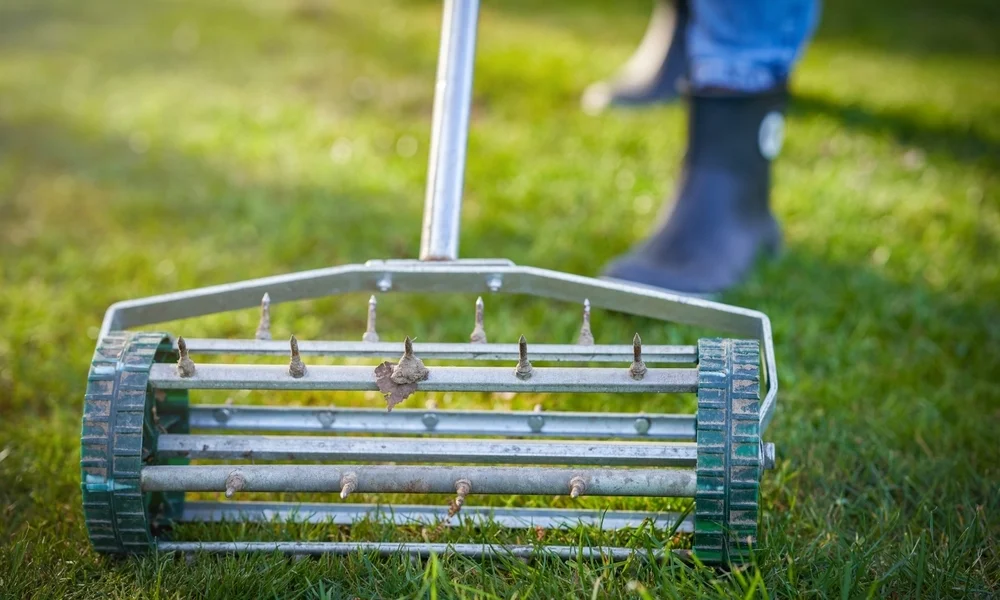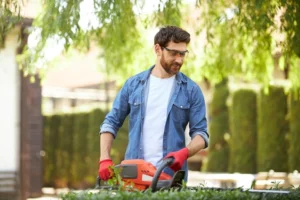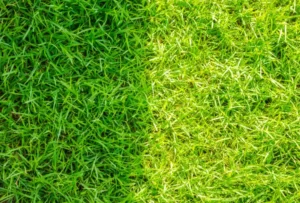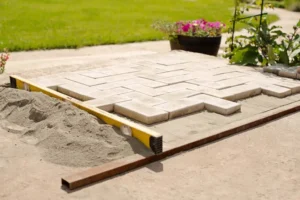How often should you aerate your lawn depends on several factors, but one thing is certain it plays a key role in maintaining a healthy, lush landscape. Lawn aeration is the process of perforating the soil with small holes to allow air, water, and nutrients to penetrate deep into the root zone. Over time, soil becomes compacted due to foot traffic, weather conditions, and routine lawn use, which restricts root growth and limits access to essential resources.
Regular aeration breaks up this compaction and revitalizes your lawn from the ground up. Healthy soil encourages deeper root systems, leading to thicker, greener grass. Aeration also enhances drainage and boosts the effectiveness of fertilizers. By understanding how often to aerate, you can promote long-term lawn health and resilience.
Why Should You Aerate a Lawn?

Boosts Lawn Health
Aeration improves overall lawn vitality by enhancing airflow to the roots. When grass roots receive more oxygen, they grow deeper and stronger, resulting in a thicker, greener lawn. It also helps turf recover from environmental stress and foot traffic.
Reduces Soil Compaction
Compacted soil limits root expansion and blocks essential nutrients from reaching the root zone. Regular aeration breaks up tightly packed soil particles, allowing roots to grow freely and absorb what they need to thrive.
Breaks Down Thatch
Thatch is a layer of dead grass, roots, and debris that builds up between the grass blades and soil surface. When thatch becomes too thick (over ½ inch), it acts like a barrier. Aeration physically slices through the thatch, promoting natural decomposition and preventing disease and pest buildup.
Improves Water and Nutrient Absorption
Aeration opens up the soil so water, nutrients, and fertilizers can sink in more deeply and evenly. This reduces surface runoff and ensures resources reach the root level where they’re most effective resulting in improved lawn density and color.
Encourages Stronger Roots
The combination of loosened soil and better nutrient availability encourages root systems to grow deeper. Deeper roots are more drought-resistant and better anchored, supporting long-term lawn health.
Enhances Soil Microbial Activity
Aeration introduces oxygen into the soil, stimulating microbial activity that naturally breaks down organic matter. This keeps the soil ecosystem balanced and healthy.
Recognizing the Signs
Knowing when your lawn needs aeration is key to timely intervention. Common signs include:
- Thinning Grass: Grass becomes sparse or patchy despite proper care
- Pooling Water: Puddles form after rainfall or watering
- Hard Soil Surface: Walking on the lawn feels stiff or bouncy
- Heavy Use Areas: High-traffic spots show signs of wear and thinning
- Poor Growth: Lawn looks dull or stressed even after fertilizing
By addressing these issues with timely aeration, you’re not just treating symptoms you’re restoring your lawn’s health from the soil up.
You may read about How Much Lawn Care Cost?
Factors That Influence Aeration Frequency
Soil Type
The type of soil in your yard is one of the biggest factors in deciding how often to aerate. Clay soils are dense and tend to compact quickly, which limits air and water flow to the roots. These lawns usually need aeration once or even twice a year to stay healthy. On the other hand, sandy soils are lighter and drain well, so they don’t compact as easily. Lawns with sandy soil may only need aeration every two to three years unless there’s heavy foot traffic.
Foot Traffic
The more people or pets use your lawn, the more often it will need aeration. High-traffic areas like spots near sidewalks, play zones, or places where outdoor events are held experience faster compaction. The soil becomes hard, which prevents roots from growing properly. If your lawn gets used frequently, aim to aerate at least once a year to relieve compaction and keep your turf healthy.
Lawn Age and Condition
Older lawns that have been in place for many years are more likely to have compacted soil and thick layers of thatch. Similarly, lawns that haven’t been aerated in a long time or show signs of poor health like slow growth or patchy grass benefit greatly from regular aeration. Aerating once a year helps restore airflow to the roots and gives the lawn a better chance to bounce back.
Climate and Season
The climate in your area and the type of grass you grow also affect when and how often you should aerate.
- Cool-season grasses (such as Kentucky bluegrass, fescue, or ryegrass) grow best in spring and fall, which are also the best times to aerate.
- Warm-season grasses (like Bermuda, St. Augustine, and zoysia) grow actively during late spring to early summer, so that’s when aeration should be done for best results.
In regions with heavy rainfall or poor drainage, aeration may be needed more often to prevent compacted, soggy soil. In drier climates, it can help loosen the soil and improve water absorption.
Lawn Care Practices
Regular mowing, watering, and fertilizing help your lawn, but they can also contribute to thatch buildup and surface compaction over time. Even well-maintained lawns can become compacted from routine care. Aerating every 1–2 years ensures nutrients continue to reach the root zone effectively.
By considering these factors soil type, usage, age, climate, and lawn care habits you can create a custom aeration schedule that keeps your lawn in top condition all year long.
How Often Should You Aerate Your Lawn?

General Recommendation
Most lawns should be aerated once a year to stay healthy and strong. However, if your lawn is in good shape and doesn’t get much foot traffic, aerating every other year may be enough.
Adjusting Based on Lawn Conditions
You may need to aerate more often if:
- The soil feels hard or compact
- Water pools on the surface after rain
- Grass looks thin or weak
- You have heavy clay soil or lots of foot traffic
In these cases, aerating twice a year once in spring and once in fall can help improve your lawn’s health.
Best Time to Aerate (by Grass Type)
- Cool-season grasses (like fescue, bluegrass, ryegrass):
Aerate in early spring or early fall, when the grass is growing actively. - Warm-season grasses (like Bermuda, zoysia, St. Augustine):
Aerate in late spring to early summer, when these grasses are at their strongest growth stage.
Doing it during the growing season helps the lawn recover faster and fill in any holes.
Residential vs. Commercial Lawns
- Residential lawns usually only need aeration once a year, unless they have a lot of use or poor soil.
- Commercial properties (like parks, schools, or sports fields) experience more wear and tear, so they often need aeration twice a year to stay green and strong.
If you’re looking for expert help with lawn care services, choose Lakota Design Group we provide customized aeration solutions to keep your lawn in top shape year-round.
When to Hire a Professional
DIY Aeration vs. Professional Lawn Care
While DIY aeration is possible, it can be time-consuming and physically demanding especially if you don’t have the right tools. Many homeowners try using manual spike aerators, but these often don’t go deep enough to make a lasting impact. That’s where professional help makes a difference.
Equipment Differences
Manual tools or rental machines can be hard to handle and may not penetrate deeply into compacted soil. Professional lawn care services use core aerators that remove plugs of soil, allowing for better air, water, and nutrient flow. These machines are more powerful, precise, and efficient for large or heavily compacted lawns.
When to Call in the Pros
Hiring a professional is recommended when:
- Your lawn is large or has uneven ground
- The soil is very compacted or dry
- You don’t have time, tools, or experience
- You want to combine aeration with overseeding or fertilizing for maximum results
Better Results with Expert Care
Professionals know the right timing, method, and frequency based on your grass type and soil condition. They also ensure even coverage, proper plug removal, and less damage to your turf. This leads to faster recovery and healthier growth.
Trust Lakota Design Group for expert lawn care services that make a visible difference. Whether you need core aeration, seasonal treatments, or full lawn renovation, we have the tools and experience to get it done right.
Ready to revive your lawn? Contact Lakota Design Group today for professional aeration and lawn care services you can count on!
FAQs
How Often Should You Aerate Your Lawn?
Most lawns benefit from aeration once a year. However, lawns with heavy clay soil, frequent foot traffic, or poor drainage may need it twice a year for best results.
What Happens If I Don’t Aerate My Lawn Regularly?
Skipping aeration can lead to compacted soil, poor water drainage, and thatch buildup, which restrict root growth and make your lawn look thin, patchy, and weak over time.
Can I Aerate My Lawn Too Often?
Yes. Over-aerating can stress the grass and damage root systems. For most lawns, once a year is enough unless your soil is extremely compacted or the lawn gets constant use.
Should I Hire A Professional For Aeration?
Yes, especially if you have a large yard, compacted soil, or want the job done right the first time. Lakota Design Group offers expert lawn care services to ensure deep, even aeration and healthier grass growth.
Can I Combine Aeration With Other Lawn Treatments?
Absolutely. Aeration is a great time to overseed, fertilize, or apply compost because the soil is open and better able to absorb nutrients.





